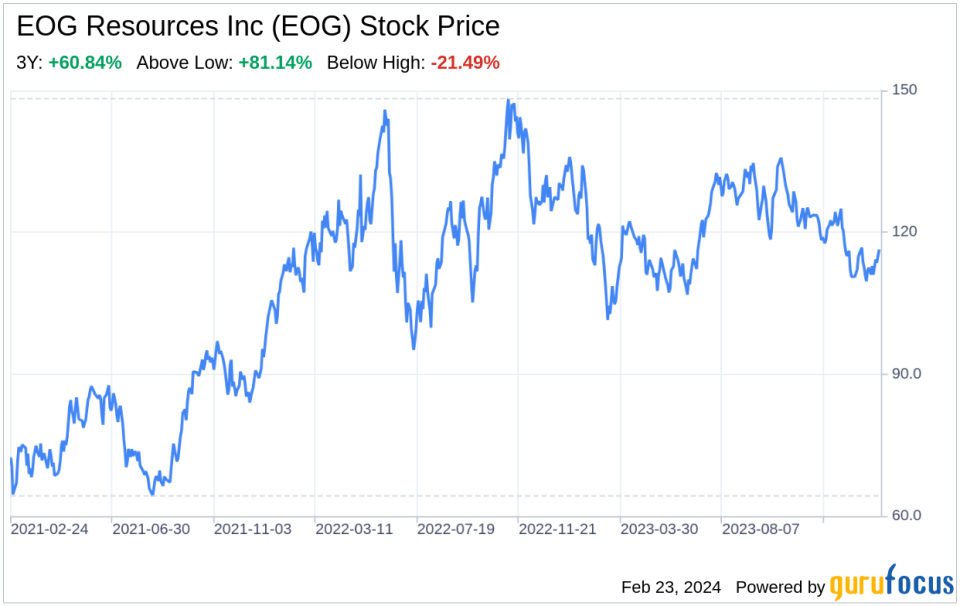Decoding EOG Resources Inc (EOG): A Strategic SWOT Insight
EOG Resources Inc showcases robust production with a strong focus on oil and natural gas liquids, comprising 73% of its net production.
Despite competitive pressures, EOG maintains a strong foothold in key U.S. shale plays, including the Permian Basin, Eagle Ford, and Bakken.
Human capital management and technological advancements position EOG for sustainable success in a volatile market.
EOG faces challenges from regulatory changes, market competition, and the inherent risks of the oil and gas industry.
EOG Resources Inc (NYSE:EOG), an established player in the oil and gas industry, filed its 10-K on February 22, 2024, revealing a comprehensive view of its financial and operational status. With net proved reserves of 4.2 billion barrels of oil equivalent and an average net production of 908 thousand barrels of oil equivalent per day in 2022, EOG's portfolio is heavily weighted towards oil and natural gas liquids, which account for 73% of its production. The company's strategic presence in several U.S. shale plays, including the Permian Basin, the Eagle Ford, and the Bakken, underscores its competitive positioning in the sector. This SWOT analysis delves into the strengths, weaknesses, opportunities, and threats as disclosed in EOG's recent SEC filings, providing investors with a nuanced understanding of the company's prospects and challenges.

Strengths
Robust Production and Reserve Base: EOG Resources Inc (NYSE:EOG) boasts a substantial reserve base with 4.2 billion barrels of oil equivalent, reflecting the company's successful exploration and production strategies. Its focus on oil and natural gas liquids, which are typically more valuable than natural gas, positions EOG favorably in terms of revenue potential. The company's average net production of 908 thousand barrels of oil equivalent per day in 2022 demonstrates its operational efficiency and ability to maintain a high output level, which is critical in a commodity-driven market.
Strategic Asset Locations: EOG's acreage in prime U.S. shale plays, including the Permian Basin, the Eagle Ford, and the Bakken, provides access to some of the most prolific oil and gas regions in the country. These strategic locations not only ensure a steady supply of hydrocarbons but also offer cost advantages due to the established infrastructure and proximity to key markets. This geographical positioning is a significant strength that enables EOG to optimize its production and distribution operations.
Human Capital and Technological Advancements: EOG's commitment to human capital management, as evidenced by its comprehensive employee engagement programs and "top workplace" recognitions, contributes to a motivated and skilled workforce. The company's investment in training and development, diversity, equity, and inclusion initiatives, and safety programs underscores its dedication to fostering a productive and innovative corporate culture. Additionally, EOG's technological advancements, particularly in hydraulic fracturing and horizontal drilling, have enhanced its operational efficiency and resource recovery rates, further solidifying its competitive edge.
Weaknesses
Capital Intensity: The oil and gas industry is inherently capital-intensive, requiring significant investment in exploration, development, and production activities. EOG's operations, particularly in unconventional shale plays, demand substantial capital outlays for drilling and completion processes. While EOG has managed its capital expenditures effectively, the need for continuous investment to maintain production levels and reserve replacement can strain financial resources, especially during periods of low commodity prices.
Regulatory and Environmental Risks: EOG operates in a heavily regulated environment, with policies affecting various aspects of its business, from drilling permits to environmental compliance. The evolving regulatory landscape, particularly concerning hydraulic fracturing and greenhouse gas emissions, poses a risk to EOG's operational flexibility and cost structure. Additionally, EOG's activities are subject to stringent environmental regulations, which can lead to increased compliance costs and potential liabilities.
Market Volatility: As a producer of commodities, EOG is susceptible to fluctuations in oil and natural gas prices. Volatile market conditions can significantly impact the company's revenue and profitability. While EOG employs hedging strategies to mitigate price risks, the effectiveness of these financial instruments is not absolute, leaving the company exposed to market volatility.
Opportunities
Technological Innovation: EOG has the opportunity to further leverage technological advancements to enhance its exploration and production capabilities. Innovations in seismic imaging, drilling techniques, and well completion methods can lead to more efficient resource extraction and cost savings. By staying at the forefront of technology, EOG can improve its competitive position and unlock additional value from its asset base.
Expansion into New Markets: EOG's strong operational foundation and expertise in shale development present opportunities for geographic expansion, both domestically and internationally. Entering new markets with untapped resources can provide additional growth avenues and diversify the company's revenue streams. Strategic partnerships and acquisitions could facilitate this expansion while mitigating entry risks.
Energy Transition and Diversification: The global shift towards cleaner energy sources presents an opportunity for EOG to diversify its portfolio and invest in renewable energy projects. By leveraging its existing infrastructure and technical know-how, EOG can participate in the energy transition, potentially tapping into new revenue sources and reducing its carbon footprint.
Threats
Competitive Landscape: EOG faces intense competition from both major integrated oil companies and other independent producers. Competitors with larger financial resources and established governmental relationships may have advantages in securing leases and accessing capital. Additionally, the rise of renewable energy sources poses a long-term threat to the demand for fossil fuels, potentially impacting EOG's market share.
Regulatory Changes: Potential changes
This article, generated by GuruFocus, is designed to provide general insights and is not tailored financial advice. Our commentary is rooted in historical data and analyst projections, utilizing an impartial methodology, and is not intended to serve as specific investment guidance. It does not formulate a recommendation to purchase or divest any stock and does not consider individual investment objectives or financial circumstances. Our objective is to deliver long-term, fundamental data-driven analysis. Be aware that our analysis might not incorporate the most recent, price-sensitive company announcements or qualitative information. GuruFocus holds no position in the stocks mentioned herein.
This article first appeared on GuruFocus.
